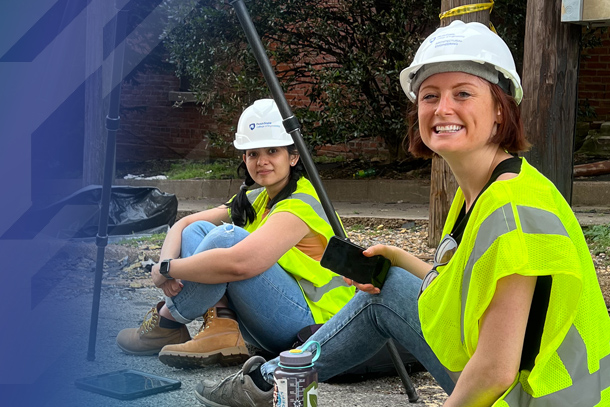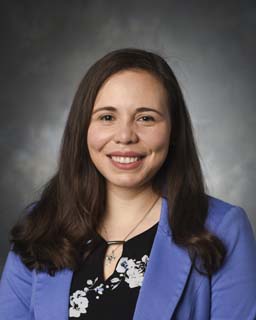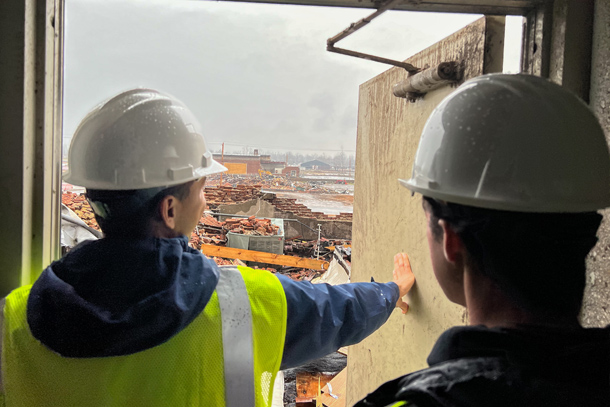“It's interesting for engineers to look at the real societal conditions to give more value and motivation toward completing their degree.”
Mariantonieta Gutierrez Soto, assistant professor of engineering design

Architectural engineering doctoral student Saanchi Singh Kaushal (left) and Assistant Professor of Architectural Engineering Rebecca Napolitano were among the researchers to travel to Mayfield, Kentucky, to capture time-sensitive data in the aftermath of a tornado. Credit: Provided by Rebecca Napolitano
ENGINEERING IMPACT
April 10, 2023
By Sarah Small
UNIVERSITY PARK, Pa. — When Saanchi Singh Kaushal arrived at Penn State as an architectural engineering doctoral student, her education had already taken her across continents, receiving first her bachelor’s degree in India and then her master’s degrees in Portugal and England. But despite her years of study of structural analysis of historic buildings at institutions around the globe, there was an experience she would not have until becoming a Penn State student: sliding on boots and a hardhat to stand in the middle of freshly downed trees and haphazardly strewn debris, surveying homes without roofs in the almost-immediate aftermath of a tornado in Mayfield, Kentucky.
“I had read about tornado zones, but last year was my first encounter with a tornado disaster — actually being on site and seeing what happens and what it does to you,” Kaushal said.
This experience — one that Kaushal has had multiple times now — exemplifies the hands-on research she has been able to conduct alongside her co-advisers, Rebecca Napolitano, assistant professor of architectural engineering at Penn State, and Mariantonieta Gutierrez Soto, assistant professor of engineering design in the School of Engineering Design and Innovation. They are all members of the national Structural Extreme Events Reconnaissance (StEER) Network. The network deploys researchers in the wake of natural disasters to capture time-sensitive data about the damage before clean-up crews go through the area.
In the past year, all three researchers have been to Mayfield twice: first in December just a few days after tornados tore through the town to produce a reconnaissance report, and again in March to collect more data after the initial clean-up efforts. On the most recent trip to Kentucky, which was funded by a National Science Foundation Rapid Response Research (RAPID) grant, they were joined by Penn State Professor of Architectural Engineering Tom Boothby, Penn State civil engineering graduate students Alejandro Palacio Betancur and David Caballero Russi and University of Kentucky civil engineering undergraduate student Garrett Demaree. Jeffrey Berman, Karen Dedinsky and Andrew Lyda, all of the University of Washington, also worked with the Penn State team on-site.
“There is something frightening about seeing destruction on the scale that we saw in Kentucky,” Boothby said. “It is sobering to see the scale of the damage and to recognize the challenges the engineering profession faces in trying to prevent or mitigate this level of destruction.”
The faculty members, who often make long trips on short notice to disaster sites, usually bring along a team of students from many different academic backgrounds. While these trips and projects may be unique, the components of the work — including student education, interdisciplinary explorations, sustainable solutions and actionable outcomes — embody much of Penn State research.
According to Kaushal, the trips took her architectural engineering from the theoretical to the practical with new challenges that only real-life situations could provide, including how to document damage to a building, a process that inherently involves subjectivity.

“It's interesting for engineers to look at the real societal conditions to give more value and motivation toward completing their degree.”
Mariantonieta Gutierrez Soto, assistant professor of engineering design
“Let’s say 50% damage is supposed to be X level of destruction to the building,” Kaushal said. “When you go on site, you realize that each person might quantify it a little differently. One goal we are working on is creating a more universal assessment so that all people who are assessing a building can come to a more similar conclusion.”
The researchers also document the damage with the remote sensing method LIDAR — which stands for light detection and ranging — and create photo models post-visit. Students, such as Kaushal, often have not employed such techniques before.
“That documentation side of the trip is at the core of this work, because we took a bunch of students who had never done a lot of these techniques,” Napolitano said. “We’re educating engineers and teaching them how to work in these scenarios.”
Documentation involves more than the current state of destruction, as Kaushal learned. She said that “picking the brains” of professional engineers and local residents provided valuable information. In Kentucky, for example, Kaushal spoke with the owners of The Clothing Mill, who provided the history and context of the building that was extensively damaged in the tornado. Kaushal also spoke with the head of the Historic Preservation of Kentucky and local community leaders to gather more information about community needs in the recovery efforts.
“It’s interesting for engineers to look at the real societal conditions to give more value and motivation toward completing their degree,” Gutierrez Soto said. “I’d like to try to do something like this as part of the classroom experience for first years, so they understand the real-world impact of engineering more immediately.”
The researchers and students on the trips have varied backgrounds, from civil and electrical engineering to meteorology and geology. This allows them to take a holistic view of the research and inform sustainability, equity, historic preservation, future best building practices and more.
For example, Muhammad Rakeh Saleem, the Penn State architectural engineering doctoral student with a background in electrical engineering, programmed drones to photograph damage that researchers could not safely survey in person.
“I feel like if you're not doing something collaborative, you're not doing something Penn State,” said Napolitano, who researches historic structures.
In Mayfield, Napolitano said, many of the historic buildings are cobbled together, with the original structure built over a hundred years ago and additions and repairs made with different techniques at different times since then. Her team investigates what works and what does not in terms of surviving a disaster and how to best repair damaged historic buildings. Gutierrez Soto, meanwhile, focuses on how to rebuild with best practices.
“My group is looking at what do we have, what can we use?” Napolitano said. “Like if a three-foot wall is fine, but a two-foot wall is not, can we do an abutment for two-foot walls? Mariant is making new, and I’m making do.”
Gutierrez Soto is also interested in an equity component — how different communities might respond to similar disasters depending on their resources. In addition to visiting Mayfield, she also led a team in response to a tornado near New Orleans in March.
“Mayfield and New Orleans were interesting cases to compare, because the ways that the communities responded to the tornados were very different,” she said. “New Orleans is urban and more accustomed to natural hazards, and Mayfield is rural. Three months after the tornado in Mayfield, there were still structures that looked exactly like they did immediately after the tornado.”
According to Gutierrez Soto, the context of communities — including their experience with natural disasters and how each state allocates resources for recovery and has different policies related to disaster relief — factors into recovery efforts.
“When we were in New Orleans, it was a completely different story, because that community is constantly challenged with natural hazards,” Gutierrez Soto said. “We were there trying to assess tornado damage just days after it happened, and people were already fixing roofs. At the same time, we saw some people just outside of the disaster zone fixing their homes, and we asked, ‘Did the tornado hit here?’ and they said, ‘No, this is from an earlier hurricane.’ They are faced with these challenges all the time, and it’s amazing how resilient they are.”
Part of the resiliency is in building back stronger and sustainably, Gutierrez Soto said, explaining that prevention might be more effective from both a cost and environmental standpoint than recovery.
“If you invest to make your structures resilient, then you don’t have to think about disaster management — your structure is surviving and thriving,” Gutierrez Soto said. She explained that although there is a more significant carbon cost in rebuilding from the ground initially, the cost over years may be less substantial than continued repairs. “If you build your structure in the best possible way, it becomes a sustainable solution.”

Students survey the tornado damage in Mayfield, Kentucky. Credit: Provided by Rebecca Napolitano
Napolitano didn’t disagree but mused about how researchers could definitively pin down a “best practices” solution.
“What is the best possible way, though, because the best possible way, we keep changing it,” Napolitano said, noting that what may be considered sustainable today could be different in the future and that what’s sustainable for one community may not be for another. “We don’t know, and climate change keeps getting harsher. It’s really tricky to determine a single solution.”
For all multifaceted, complex collaborations among students, professors, locals, civil engineers studying resilient design, electrical engineers focused on artificial intelligence, geologists improving map tools and architectural engineers concerned with sustainability, perhaps the keystone of the research, lays in an exchange between Gutierrez Soto and Napolitano.
The two researchers engaged in an open dialogue when they began their work, landing on the fundamental research starting point: ‘I don’t know. Let’s find out.’